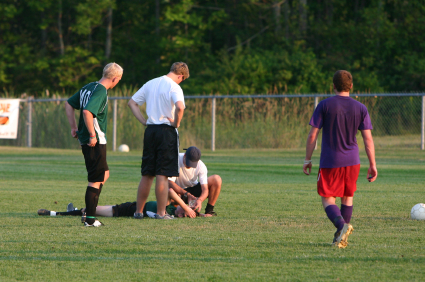Coaches in youth sports, particularly at levels below high school, are often on the front-lines of injury treatment, with no athletic trainer or team doctor to turn to when a player is injured. With concussion safety and education laws now in place in nearly every state, coaches play an increasingly important role in concussion safety, especially in the all-important decision about whether to remove an athlete from play for further evaluation. 
If you are a coach, and suspect that one of your athletes has suffered a concussion, then, regardless of the level at which you coach or what the law requires in your area, the following four steps should be taken:
First, remove the athlete from play. Laws in virtually every state now mandate immediate removal from play of athletes exhibiting any signs and symptoms of a concussion, a conservative practice that all major medical groups involved in youth sports have been advocating for many years. Remember the mantra: "When in doubt, sit them out."
Second, ensure that the athlete is checked out by a health care professional experienced in evaluating for concussion. Do not try to judge the severity of the injury yourself. Health care professionals have a number of methods that they can use to assess whether an athlete has suffered a brain injury such as a concussion and its severity. As a coach, recording the following information can help health care professionals in making that assessment:
- the cause of injury and the force of the hit or blow to the head or body. Remember, it is a myth that only blows directly to the head cause concussion (for an article debunking this and some other of the most widespread concussion myths and misconceptions, click here). In addition, evidence that a concussion occurred from a minor blow, especially in an athlete with a history of prior concussions, is considered an important factor in concussion management, suggesting a longer recovery time for return to play, and, in some instances, warranting a recommendation to retire from contact or collision sports;
- any loss of consciousness (LOC) (passed out/knocked out), and, if so, for how long. While LOC, contrary to myth, is not required for a concussion finding (in a recent study of high school athletes with concussion was present in less than five percent of concussions), and studies show that a brief LOC (less than a minute) does not reflect injury severity or predict the length of recovery, prolonged loss of consciousness (30 seconds to a 1 minute or greater) does provide preliminary evidence for caution so that it is listed as one of the "modifying" factors that may influence management of such concussions.
- any memory loss (amnesia) immediately following injury. An athlete can experience two types of amnesia after a concussion: anterograde (reduced ability to form new memories) and/or retrograde (partial or total loss of the ability to recall events before injury). While retrograde amnesia varies with the time of measurement after injury, is thus is considered a poor measure of injury severity, especially because athlete often hears peers, family, and coaches discuss events surrounding the injury, making it more likely that they will subsequently falsely report remembering more about the injury.1, 2 An impaired ability to form new memories (anterograde amnesia), however, remains an important indicator of potentially more serious brain injury, which often takes longer to heal.2,3
- Any seizures immediately following the injury.
- Number of previous concussions (if any)
Third, inform the athlete's parents or guardians about the possible concussion and give them a fact sheet on concussion. Make sure they know that the athlete should be seen by a health care professional experienced in evaluating for concussion and that it is important for them to monitor the athlete carefully for the first 24 to 48 hours after concussion for signs of deteriorating mental status requiring immediate hospitalization.
Fourth, don't allow same day return to play or return until athlete receives medical clearance. Keep the athlete out of play on the day of the injury and until a health care professional, experienced in evaluating for concussion, says they are symptom-free and it's OK to return to play. A repeat concussion that occurs before the brain recovers from the first - usually within a short period of time (hours, days, or weeks) - can slow recovery and/or increase the likelihood of the athlete experiencing long-term problems. In rare cases, another blow to the head, even one that might otherwise not cause a concussion, while the brain is still recovering from an earlier concussion can result in edema (brain swelling), permanent brain damage, and even death (second impact syndrome).
Sources: Numerous, including Centers for Disease Control (CDC).
Footnotes:
1. Collins MW. Update: concussion. Presented at the American Orthopaedic Society for Sports Medicine 2009 annual meeting; July 9-12, 2009; Keystone, CO.
2. McCory, P. et al. Consensus statement on concussion in Sport: the 4th International Conference on Concussion in Sport held in Zurich, November 2012. Br J Sports Med 2013;47:250-258.
3. Halstead, M, Walter, K. Clinical Report - Sport-Related Concussion in Children and Adolescents. Pediatrics. 2010;126(3):597-615.
Updated March 27, 2015









